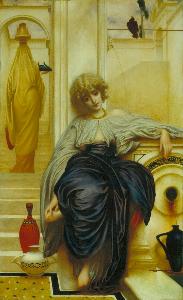Frederic Leighton, 1St Baron Leighton
Frederic Leighton, 1St Baron Leighton;Frederic Leighton
Place: Scarborough
Born: 1830
Death: 1896
Biography:
Early Life and Education
Frederic Leighton, a renowned British painter, draughtsman, and sculptor, was born on December 3, 1830, in Scarborough, United Kingdom. His family's wealth, courtesy of his grandfather's successful medical practice for Russian tsars, provided him with the means to pursue his artistic endeavors. Leighton received his early education at University College School, London, followed by artistic training under Eduard von Steinle and Giovanni Costa.
Artistic Career
Leighton's works, characterized by their academic style, often depicted historical, biblical, and classical subject matter. His paintings were highly popular and expensive during his lifetime, but fell out of favor in the early 20th century. Notable works include:
- June Flaming (1895; Museo de Arte de Ponce), a masterpiece showcasing Leighton's skill with vibrant colors.
- After Vespers (1871; Princeton University Art Museum), a poignant piece reflecting the artist's ability to capture emotional depth.
- Cymon and Iphigenia (218 x 390 cm, Art Gallery of New South Wales, Sydney, Australia), a sculpture that marked the beginning of a renaissance in British sculpture, known as the New Sculpture.
Achievements and Legacy
Leighton was elected President of the Royal Academy in 1878, a position he held until his death. He also designed Elizabeth Barrett Browning's tomb for Robert Browning in the English Cemetery, Florence, in 1861. Leighton's contributions to British art are undeniable, with his works representing Britain at the 1900 Paris Exhibition. Important Links:
- Discover Frederic Leighton's "The Bath of Psyche" (Tate Britain, London, United Kingdom)
- Explore Frederic Leighton's Artworks on Wikioo.org
- Read more about Frederic Leighton on Wikipedia
Museums and Collections
Leighton's works can be found in various museums, including the Tate Britain (London, United Kingdom), Princeton University Art Museum (United States), and the Art Gallery of New South Wales (Sydney, Australia). His legacy continues to inspire artists and art enthusiasts alike. Lord Frederic Leighton, a true master of British Victorian art, left an indelible mark on the world of painting and sculpture.



